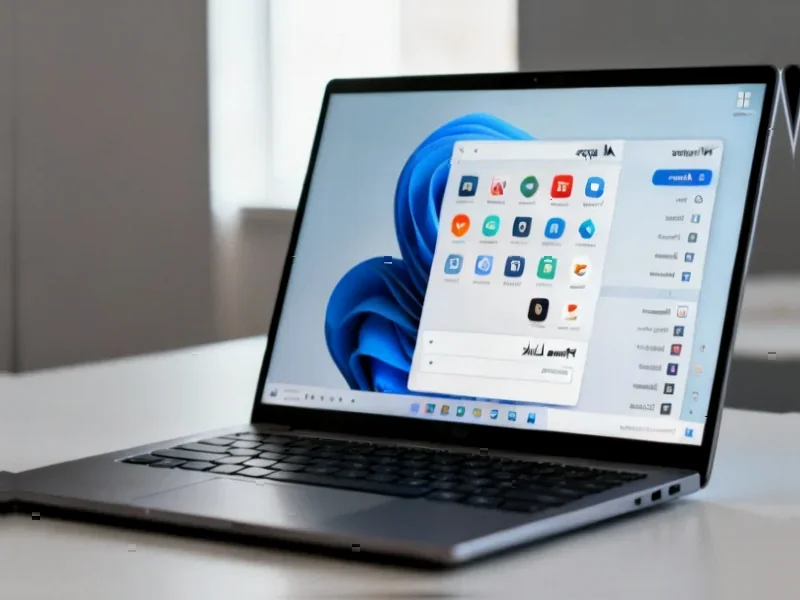According to PCWorld, Microsoft is testing a new feature in Windows 11 that enables simultaneous audio streaming to two wireless devices, such as headphones or speakers. The feature requires Bluetooth LE support on both devices, offering lower power consumption and better sound quality. Currently available only in Dev and Beta versions of Windows 11, the functionality works primarily on certain Copilot+ PCs including newer Surface models and some Samsung Galaxy Books. Users can access the feature through the Shared audio (preview) option in quick settings, with general availability expected later. This development signals a significant shift in how multiple users can share audio experiences without disturbing others.
The End of Audio Isolation
Microsoft’s move fundamentally challenges the single-user paradigm that has dominated personal computing audio for decades. While Bluetooth technology has enabled wireless freedom, it has simultaneously created audio isolation where each user is confined to their own device. This feature bridges that gap, creating new social computing scenarios that could drive hardware sales and software engagement. The timing is strategic as Microsoft positions Windows 11 as the platform for collaborative and shared computing experiences, directly competing with Apple’s ecosystem strengths in media consumption and sharing.
Winners and Losers in the Audio Hardware Space
The immediate beneficiaries will be headphone manufacturers whose products already support Bluetooth LE, particularly those in the premium segment where this technology is standard. Companies like Sony, Bose, and Sennheiser stand to gain from increased demand for compatible devices. However, manufacturers still relying on older Bluetooth standards may face accelerated obsolescence. The feature also creates opportunities for accessory makers to develop specialized products for shared listening scenarios, potentially including multi-user gaming headsets or specialized audio-sharing accessories for educational and professional settings.
Microsoft’s Broader Ecosystem Play
This isn’t just about convenience—it’s a strategic move to strengthen Microsoft’s position in the Windows ecosystem. By introducing features that enhance shared experiences, Microsoft makes Windows more appealing for family and shared living situations. This could help counter the trend toward mobile-first computing by emphasizing scenarios where Windows still dominates: productivity, entertainment, and creative work. The requirement for Copilot+ PCs in the initial rollout suggests Microsoft is using this feature to drive adoption of their latest hardware specifications, creating a compelling reason for users to upgrade beyond raw performance improvements.
The Coming Standards Battle
Microsoft’s implementation using Bluetooth LE sets the stage for potential standards conflicts with other technology giants. Apple has its own ecosystem-based solutions through AirPlay and Share Audio features, while Google has been developing similar capabilities through Fast Pair and nearby sharing. The success of Microsoft’s approach could influence how Bluetooth LE Audio becomes adopted across the industry. If Windows 11’s implementation gains traction, it could pressure other platform providers to offer similar capabilities, potentially leading to fragmented implementations that complicate cross-platform compatibility.
Beyond Consumer Entertainment
The implications extend far beyond watching movies with a partner. Businesses could use this for simultaneous translation in meetings, training scenarios where multiple participants need the same audio feed, or retail environments with personalized audio experiences. Educational institutions could benefit from language labs or multimedia learning where students share audio sources. The feature’s potential in accessibility applications is particularly promising—imagine museums or public spaces where multiple visitors can simultaneously access audio descriptions without specialized equipment.
The Technical Hurdles Ahead
While promising, the feature faces significant technical challenges. Maintaining synchronized audio across multiple Bluetooth devices has historically been difficult due to latency variations. The success will depend heavily on Microsoft’s implementation of the Bluetooth Core Specification and how well they manage potential audio drift between devices. Additionally, battery life concerns become multiplied when streaming to multiple devices, and audio quality consistency across different headphone models presents another layer of complexity that Microsoft will need to address before general availability.




